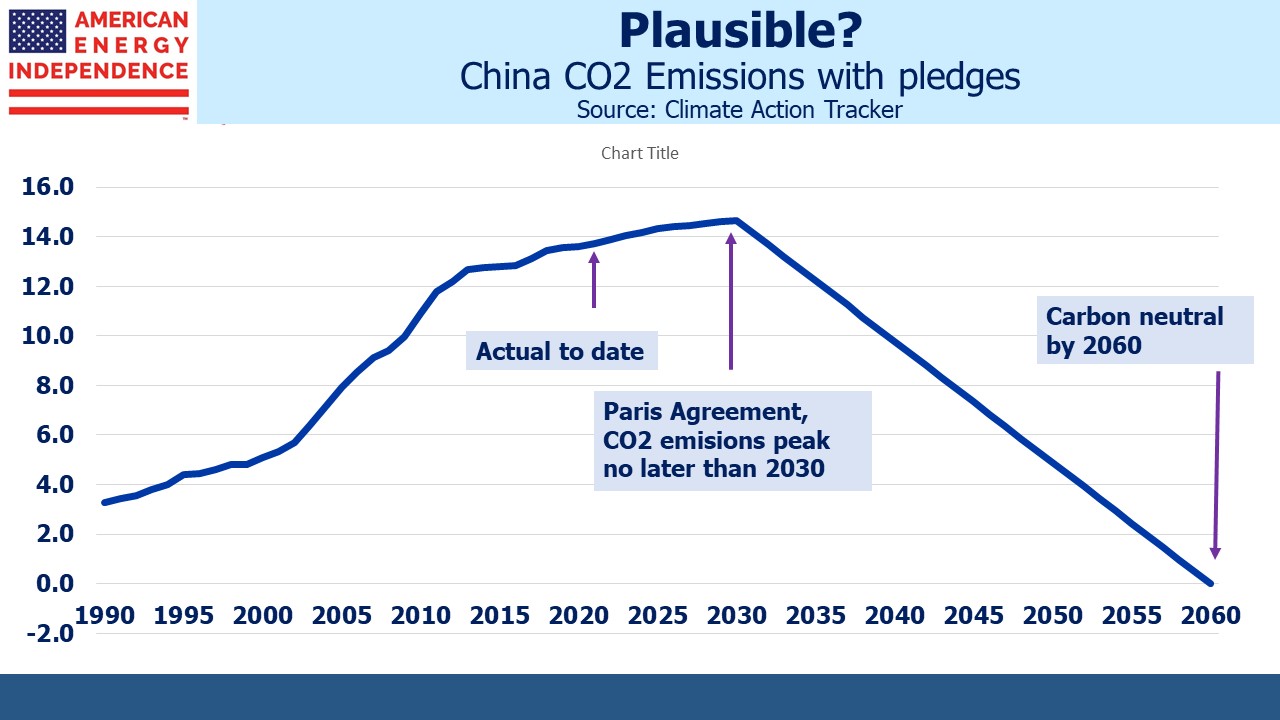Is China Worried About Global Warming?
The UN’s Intergovernmental Panel on Climate Change (IPCC) released their latest report on Monday, in preparation for COP26, the November meeting of heads of government in Glasgow to discuss how we should respond.
The report says humans have warmed the planet by 1° C since pre-industrial times, the agreed-upon benchmark. A further 0.5°C is likely on current trends within the next two decades. The New York Times, rarely short of hyperbole, misleadingly wrote, “Even if nations started sharply cutting emissions today, total global warming is likely to rise around 1.5 degrees Celsius within the next two decades, a hotter future that is now essentially locked in.” This sounds like an additional 1.5° over the next 20 years, unless you’ve read the IPCC Summary for Policymakers.
Putting aside biased news coverage, the most important question is what does China think? The IPCC’s summary presents a sober case that the world needs to begin dramatically cutting CO2 emissions from fossil fuel use with a view to reaching carbon neutrality by 2050. Only then can we be assured that the remaining capacity of the atmosphere to absorb additional CO2 will not be exhausted, with irreversible consequences.
As with most things, actions count for more than words. Even though we’re supposed to cut emissions now, China plans to keep increasing them until 2030. At that point, an improbable pledge to be carbon neutral within three decades is supposed to usher in a sharp decline. While China could perhaps do this, there’s good reason to doubt they will.
How must Chinese policymakers regard their choices? Real per capita GDP has grown at 5% pa since 1980, three times the US rate. It wouldn’t have happened without higher energy use. Yet even now, China is at less than 24% of the US level. The looming energy transition is hugely expensive and negative for growth.
Improving living standards beats climate in China. They likely deem the increased incidence of heatwaves and extreme weather as inconsequential. Although much of the western media appears almost suicidal over the planet’s future, everyday life for the typical Chinese citizen (or US for that matter) isn’t visibly impacted by the 1°C warming we have engineered so far.
While the science of human-caused warming is generally beyond question, predicting the consequences is far harder. The UN has an unfortunate track record of offering dire predictions that miss, although the science is presumably now better than ever. Chinese citizens, if they think about it, may even conclude that the current climate isn’t necessarily the best we could have.
Like many people, I spend far more time and money coping with excessive cold rather than heat. I head to Florida as soon as the daytime high in New Jersey drops below a golf-impeding 50°F. Cold weather is miserable. If human-induced Global Cooling threatened, I’d find that far more distressing — it might get me to join the Sierra Club. But a slightly warmer planet, like a slightly warmer day, doesn’t sound so bad. The Chinese probably feel the same way.
Despite the absence of any meaningful weather impact, as a matter of risk management, it seems sensible to take the science seriously. As an investor, it’s important to assess the likely outcomes.
Emerging economies are where energy use, emissions and living standards are growing fastest. Regardless of its pronouncements, China shows every sign of valuing continued growth of living standards over reduced energy use to lower CO2 emissions. Non-OECD countries emit around two thirds of global CO2, and this is growing at eight times the pace of rich countries. China and India count for 35% of the total. Although both countries regularly highlight renewable energy, they’re using more of everything, including coal. Their energy needs continue to rise.
Moreover, emerging economies want money from rich countries to finance green energy investments. $100BN per year was pledged but not delivered last year. Some are asking for far more (listen to our recent podcast, Episode 79: The Bill For The Energy Transition to hear South Africa’s Environment Minister telling citizens substantial foreign aid is needed). This receives no attention in the US media but certainly does in supplicant countries. The Biden Adminstration recognizes that US political support for the energy transition doesn’t mean voters are willing to pay for it.
High crude oil prices are a necessary step in inducing drivers to switch to electrric vehicles, but the White House continues to urge increased production from OPEC. National Security Advisor Jake Sullivan called for, “Americans to have access to affordable and reliable energy, including at the pump.” It remains the case that there are votes in appearing to push for the energy transition but fewer in executing, which is why Democrats continue to be good for the sector.
The inevitable conclusion is that climate change is occurring too slowly and with too limited impact to cause the dramatic behavioral changes called for by the IPCC. Western countries are moving aggressively to confront it, but the most likely outcome is that we’ll be stuck with the negative consequences of ever more solar panels and windmills without seeing any discernible impact on global CO2 emissions. Even though the IPCC report warns that populations in poorer countries are most vulnerable to heatwaves and rising sea levels, their energy consumption shows they deem increasing living standards to be more important.
We’re going to adapt to a modestly warmer planet, while at the same time pursuing policies that reduce CO2 emissions. Coal to natural gas switching remains a big global opportunity, and US LNG export growth remains a bright spot for the domestic energy business. But the conflicting goals of raising living standards versus lowering emissions will continue to dominate the outcome.
We are invested in all the components of the American Energy Independence Index via the ETF that seeks to track its performance.


